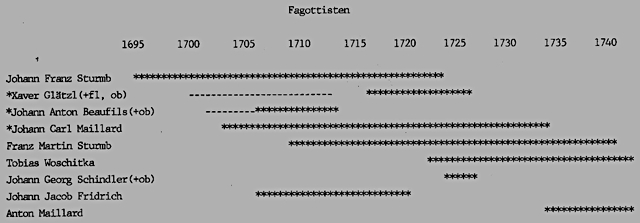Twelve Vienna arias by various composers
Abschriften in Sammelband Mus. Hs. 17051, Libero Terzo, fol 59r
Musiksammlung der Österreichischen Nationalbibliothek, Wien
This is a unique compilation, over 260 years old, of 12 arias
with obbligati for one or two bassoons.
Incipits of these twelve arias from this Sammelband (collected volume) and the photocopied solo part of the Mitridate aria are reproduced here for personal study with generous permission of the Österreichischen Nationalbibliothek, Wien
http://www.onb.ac.at/sammlungen/musik/musik_bestandsrecherche_musikhandschriften.htm
The pp numbers refer to double pages in the Sammelband.
|
Aria dell’Opera Spartaco Note: This aria with bassoon obbligato is not included “Volgi mi piu serena” for bass, fagotto solo, continuo, |
pp 3-14 |  |
|
Aria dell’Opera Mitridate In the listing for Caldara, a modern edition of score and parts for this aria is reproduced with generous permission of Mélodie Michel and Ricardo Simian, Basel. |
pp 15-24 |  |
| Aria del Oratorio La Distruzione d’Ataj “Se potesse la mia mente”, del Sigr Ignazio Conti Alto, 2 vln, vla, fagotto solo, continuo |
pp 25-32 |  |
| Aria del Componimento di Camera Il Tempio di Giano Chiusa da Cesare Augusto “Troppo e ormai cheti lusingati”, del Sigr Guiseppe Porsile Bass, 2vln, vla, fagotto, continuo |
pp 33-38 |  |
| Aria del servicio di Camera La Clemenza di Cesare “Racchiuso nel seno un core” del Sigr Gios Porsile Soprano, 2vln, vla, fagotto solo, continuo |
pp 39-44 |
 |
| Aria del Oratorio L’Elabrazione di Salomone “Pien di giubilo ogni core”, del Sigr Guiseppe Porsile Bass, 2vln, vla, fagotto solo, continuo |
pp 45-51 |  |
| Aria Oratorio Il Testamento Di nostro Signor Gesu Christo “Scende l’uomo” del Signor Gio Gius Fux Bass, 2vln unis, fagotto, continuo |
pp 51-59 |  |
| Aria del Componimento da Camera Orfeo ed Euridice “Per regnar con piu gloria” del Sigr Gio Gius Fux Tenor, fagotto 1, fagotto 2, continuo See Fux entry for published sources |
pp 59-63 |  |
| Aria del Oratorio Gionata “Occhi, che vi fissate nel sole”, del Sigr Antonio Caldara Bass, due fagotti concertati, continuo |
pp 63-70 |  |
| Aria del Oratorio Abele “Quanto piu sei feroce” del Sigr Giov. Reutter Bass, fagotto primo, fagotto secundo, continuo |
pp 71-76 |  |
| Aria dell’opera I due Dittatori “Non dovria chi impera e regge” del Sigr Antonio Caldara Bass, due fagotti concertati, continuo |
pp 76-82 |  |
| La desposizione dalla Croce Jesu Christo Salvator Nostro, Aria del Sepulcro #14 “Se pura piu nel core”, del Sigr Giov Giuseppe Fux Bass, fagotto solo, continuo |
pp 82-86 |  |
|
Who first played these arias? The many virtuoso instrumental parts in vocal works from the Vienna court in the period 1700-1740, raise the question of who first played these obbligati. The special importance and status of instrumental players at the Vienna court is apparent from the nineteenth century Köchel biography of Fux (1). However, Seifert (2) points out that Köchel’s chronology may not be accurate, because he did not consult other sources that documented player employment at the court.
Two translations from the Köchel biography of Fux, are as follows:
Tobias Woschitka, imperial bassoonist from Liechtenstein, arrived in April 1721 to become imperial bassoonist. Fux recommended his acceptance “although we at present have four bassoonists, only a couple are still fit for service, to the detriment of our performances. Also, the applicant is a competent virtuoso”
In 1727, the imperial Fagottist Johann Jacob Friederich received a salary increase. Fux wrote: “although the applicant has not been in imperial service very long, he is a particular virtuoso who does a lot of playing, so that hardly a week goes by in which he is not heard once or twice with great satisfaction by the nobility”. Fux recommended a bonus of 300 florins. In April 1733 the salary increase amounted to 1080 florins. Although Fr. as one of the youngest Fagottisten already enjoys the highest salary of 1000 florins, Fux was not against the most recently sought increase, because Fr. was a special virtuoso. On the same matter in 1737, Fux confirmed that the applicant is a special virtuoso on his instrument and in addition to his normal duties, often entertains the nobility with solo playing.
Glüxam (3, pp 504-6) in considering the identity of these players, has emphasized the importance of Friederich/Friderich in demonstrating the iinstrument at a peak level of virtuosity in the first half of the eighteenth century.
1. Köchel, Ludwig, Ritter von: “Johan Josef Fux. Hofcompositor und Hofkapellmeister der Kaiser Leopold 1, Josef 1, und Karl V1 von 1698 bis 1740.” Verlag von Alfred Holder, Wien, 1872. http://www.archive.org/stream/johannjoseffuxh00kcgoog/johannjoseffuxh00kcgoog_djvu.txt
2. Seifert H “Die Bläser der kaiserlichen Hofkapelle zur Zeit von JJ Fux” In: Johann Joseph Fux und die Barocke Bläsertradition pp 9-23. Hans Schneider Verlag, Tutzing, 1987.
3. Glüxam, Dagmar “Instrumentarium und Instramentalstil in der Wiener Hofoper zwischen 1705 und 1740” Hans Schneider Verlag, Tutzing 2006
Seifert's summary of Fagottisten chronology (2). However, the career of Friderich extended well beyond 1723, possibly until his death in 1741. |
||
